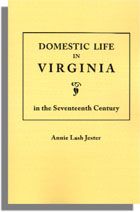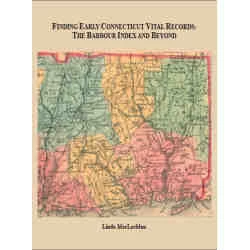
Have you ever wondered what life was REALLY like for our 17th-century ancestors? How did they dress; in fact, how did they make their clothing? What did they use to decorate their meager (or not so meager) dwellings? How did men relate to women? What was their diet on a daily basis? How often did they bathe? And on and on?
A number of years ago, historian Annie Lash Jester gathered her findings on this subject in the small book entitled Domestic Life in Virginia in the 17th Century, which we have just reissued. The following brief excerpt from the book–based on the famous “Muster of the Inhabitants of Virginia, January 1625,” which was conducted following the dissolution of the Virginia Company of London–sheds much light on a number of these issues. For more information about the other topics covered in Ms. Lester’s diminutive book, please visit the URL at the conclusion of this section.
“The dissolution of the Virginia Company in London, May 1624, left the colony without restriction to independent traders, who shortly began to respond to the colonists’ eagerness for supplies from overseas. There is, however, a record of the Colony at the conclusion of the Company’s administration taken just ahead of the influx of the accelerated trade.
“As the Company was about to be dissolved, Captain John Harvey (later as Sir. John Harvey, Governor of Virginia) was sent over to obtain exact information as to the number of people in Virginia, their names, where they lived and what supplies and arms they possessed. The document preserved in the British Public Record Office shows as to what degree the planters had spread their homes along both banks of the James River from Henrico to Elizabeth City and Kecoughtan at the confluence of the James River with the Chesapeake Bay (this point, now Hampton.Roads) and on the Eastern Shore. In addition to the names of all persons living in the colony, the ages of many are given, together with the times of their arrival, and the names of the ships on which they came. Also, those recently deceased are listed.
“The 1232 persons living in Virginia, January, 1625, dwelt at twenty-five locations. Several of these were large plantations, such as Peirsey’s Hundred, Mr. Treasurer’s (George Sandys’), Martin’s Hundred, Captain Roger Smith’s, Captain Samuel Mathews’, Mr. Crowder’s, Mr. Blaney’s and Newport News, where colonists lived in groups, presumably as employees for the promotion of extensive enterprises. As previously mentioned a number of these colonists at Henrico, James City, Charles City and Elizabeth City were living on the Company’s land. Yet, many at this time dwelt upon their own acreages, assigned to them individually in patents of record in a list sent to England the following year. For instance. Lieutenant John Chisman and his brother Edward were living at Kecoughtan on their patent of 200 acres, as was Pharoah Hinton who had been assigned. an 150 acre plot, and John Bush with his 300 acres, where he dwelt with his wife, two children and two servants, For protection against the Indians, palisades had been erected at a number of the Plantations.
“Staples on hand are listed for every household, including corn, peas, beans, oatmeal, fish, the latter both smoked and in brine. Besides, many of the planters owned swine, poultry, goats and cattle. A few luxuries were mentioned such as a flitch of bacon, cheese and oil. For protection, the colonists possessed armor such as had been used in England, but which probably proved to be of little use against the stealthy natives in thickly wooded areas. Nevertheless, there were whole suits of armor, including headpieces, coats of mail and coats of plate and jack-coats (thickly padded. jackets). The guns were of various types. Many apparently were of the older design and the charge had to be fired by the application of a fuse; others had been fixed with the more up-to-date firing mechanism attached to the pun. There were also matchlocks, snaphaunce pieces, pistols, swords and hangers (cutlasses). For the larger plantation there were small cannon, called murderers, usually placed at the bow of a ship to prevent boarding, falconets and petronels. The matches mentioned were the slow–burning fuses, kept by a soldier in his bandoleer. Once ignited, these matches kept a smouldering fire and could be used again and again. Pirates were accustomed to stick them lighted in their beards and hair, not to give a ferocious look, but for convenience.
“Powder and lead also were on hand in many households, for life, on the edge of a wilderness with stealthy Indians frequently lurking about, was hazardous in the extreme. Men who worked in the fields took fowling pieces with them and, at times, armed guards were stationed to be on the lookout, and warn the workers in case of danger.
“Among other possessions listed were the houses of the planters, their boats—barks, shallops and skiffs being named—-and, at George Sandys` plantation across from Jamestown., a house for silkworms had been framed. The prolific growth of mulberry trees, about the Indian settlements and elsewhere, encouraged the English to conclude that Virginia was an ideal location for development of the silk industry. Greatly encouraged from England, the colonists made earnest efforts, throughout the seventeenth century, to establish the culture and production.of silk on a paying basis. However, the lure of profit accruing from the easy tobacco crop, plus the difficulty in obtaining for the Colony killed silk workers, resulted eventually in the abandonment of the undertaking.”





